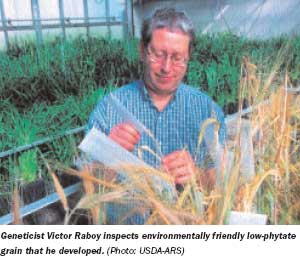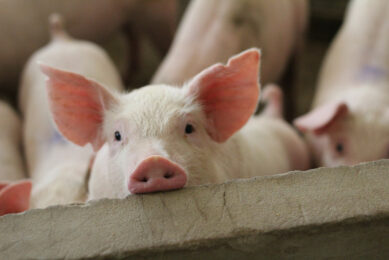Trout studies seek superior strains growing on grains

At fish geneticist Ken Overturf’s lab, research is indeed coming along swimmingly. Overturf, perhaps for the first time, has pinpointed families of captive rainbow trout that thrive on grain. This development could be a boon not only for fish farmers, but also for the environment.
Most of today’s trout feed relies on protein-rich fishmeal produced from marine species like anchovy, menhaden, jack mackerel or herring. But substituting grain for fishmeal could help reduce the threat of overfishing of these ocean resources. And since grain is a less expensive source of protein than fishmeal, grain-fed fish should be cheaper to raise. Today, feed is producers’ biggest expense.
Other studies under way in Overturf’s lab may make a similar splash in the world of commercial aquaculture. For example, he’s well on the way to pinpointing telltale patterns in trout genetic material, or DNA, that reveal whether the fish will flourish on grain-based rations. Findings from this work may speed and simplify the process of selecting out these fish from their hatchery cohorts.
Overturf works with thousands of sleek, shimmering rainbow trout, Oncorhynchus mykiss, at the University of Idaho’s Hagerman Fish Culture Station in Hagerman, Idaho.
Which fish thrive on grain-based feeds?
In his study of trout’s ability to prosper on grain-based feed, Overturf worked with three commercial trout strains and a strain grown at federal hatcheries.
Feeds used for decades to nourish farm-raised trout “don’t typically have grains such as wheat or barley in them,” says Overturf. For his tests, feed pellets made from a commercial barley variety called Waxbar provided 40% of the animals’ rations. In all, he has monitored growth of some 14,000 trout in tanks at the Hagerman station.
Overturf found that a significant percentage of the trout thrived on the grain-enriched feed. Some grew to a hefty 250 grams in as little as five months, making them equal in size to the biggest of their fishmeal-fed counterparts.
Selecting trout with DNA techniques
In DNA analyses, Overturf and technician Dan Bullock are looking for important patterns in the series of building blocks, called nucleotides that make up lengths of DNA. Those patterns may turn out to be indicators of the presence or absence of genes that enable the fish to thrive on grain-based feeds.
These genetic indicators could become the basis of a quick, easy-to-use and inexpensive test for identifying grain-tolerant fish. Those individuals could be used as parents, or brood stock of new generations of trout that will gobble grain-based pellets.
“It’s very likely that the ability to gain weight and stay healthy on grain-based feed is a genetically determined trait,” says Overturf. “So now we’re looking for the genetic material that’s a reliable indicator of that trait.” Scientists elsewhere have already paved the way for such discoveries by finding, for example, trout DNA associated with valuable traits such as disease resistance.
Low-phytate frustrate phosphorus pollution
While Overturf is breeding and studying trout that have an appetite for grains, colleague Victor Raboy is breeding grains that may lead not only to impressive weight gains in fish, but also to significant gains in the health of the environment. Raboy, a plant geneticist with ARS at Aberdeen, has developed and patented a procedure for breeding grains like barley and corn that offer a unique balance of various forms of phosphorus.
Although phosphorus is an essential nutrient, some forms – such as phytate phosphorus – are more difficult for single-stomached animals like fish, pigs, and chickens to digest than other forms. Raboy has bred special lines of corn and barley that have less phytate than conventional commercial varieties.
The result? Animals digest more of the phosphorus in the low-phytate feed, meaning that they also excrete less of it. That reduces the load of phosphorus that could otherwise leach into ponds, lakes, streams, or rivers. Such phosphorus pollution has been blamed for algal blooms that steal the oxygen needed by fish, insects, and other aquatic dwellers.
Testing in rainbow trout
Overturf fed pellets containing barley from a standard variety, Harrington, or from one of three experimental, low-phytate lines. The experimental barleys contained either 50, 75, or 90% less phytate than Harrington.
Overturf was the first to test the new, low-phytate barleys in rainbow trout. “Our preliminary results indicate that as you reduce the amount of phytate phosphorus in grain, you see a corresponding increase in the availability of usable phosphorus and calcium—another mineral that’s essential for healthy fish. That happened with all three of the low-phytate barleys we studied.”
In addition, trout fed the 50% phytate barley absorbed more iron and more zinc – also essential minerals – from their feed. The zinc and iron findings are consistent with results from human studies with foods such as tortillas and polenta made from low-phytate corn.
Market scope
US fish farmers produce about 28,000 tonnes of fresh trout each year, with a farm gate value of about $51 million. Trout is high in protein and low in fat. Easy to prepare, it takes only a few minutes to fry, broil, bake, or barbecue.
Though white-fleshed trout with firm, light-coloured meat is perhaps the most familiar kind sold in this country, some markets also offer trout that boasts distinctive, salmon-coloured flesh. The rich, appealing colour results from adding astaxanthin – a healthful, naturally occurring compound called a carotenoid – to the daily feed. l
This research is part of Aquaculture, an ARS National Program (#106) described on the internet at http://www.nps.ars.usda.gov. This study was published in the December 2001 issue of Agricultural Research magazine.












